My flight touched down in Marseille on a sunny September morning and although my ultimate destination was Barjac, I couldn't help but make a small detour to visit the Château La Coste vineyards, a magical symbiosis of architecture, sculpture and natural landscape in the south of France. The complex's curator Daniel Kennedy was waiting there to show me the collection. The Tadao Ando Art Centre is a building conceived with the artist's signature elements in mind: smooth concrete, lines that are simple, modern and in tune with the vestiges of Japanese tradition, water, the dominance of light and an architectural design in perfect harmony with its surroundings. Then there's the magnificent outdoor collection comprising projects by the likes of Louise Bourgeois, Richard Serra, Tracey Emin, Frank Ghery, Jean Nouvel and Jenny Holzer to name but a few, dotted all over the landscape.
Author: Elena Cué
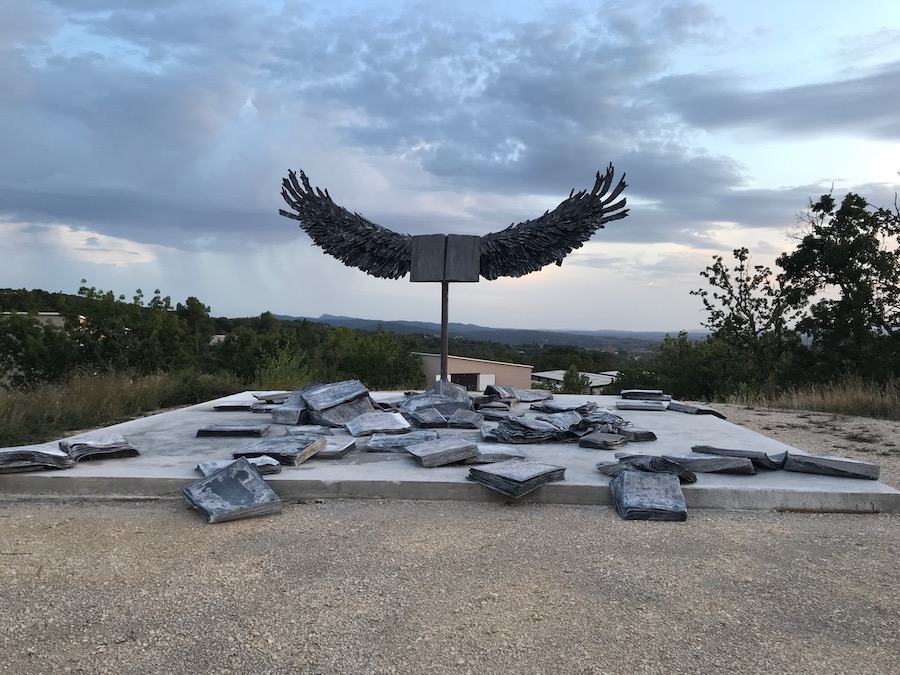
La Ribaute. Barjac. Anselm Kiefer. Photo: Elena Cué
My flight touched down in Marseille on a sunny September morning and although my ultimate destination was Barjac, I couldn't help but make a small detour to visit the Château La Coste vineyards, a magical symbiosis of architecture, sculpture and natural landscape in the south of France. The complex's curator Daniel Kennedy was waiting there to show me the collection. The Tadao Ando Art Centre is a building conceived with the artist's signature elements in mind: smooth concrete, lines that are simple, modern and in tune with the vestiges of Japanese tradition, water, the dominance of light and an architectural design in perfect harmony with its surroundings. Then there's the magnificent outdoor collection comprising projects by the likes of Louise Bourgeois, Richard Serra, Tracey Emin, Frank Ghery, Jean Nouvel and Jenny Holzer to name but a few, dotted all over the landscape.
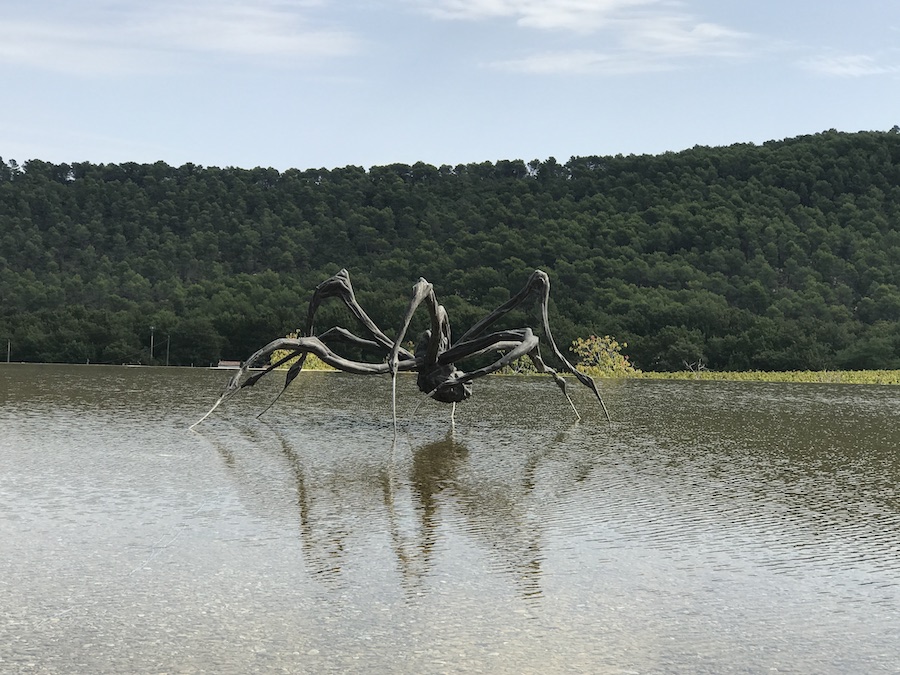
Maman. Louise Bourgeois. Château la Coste. Photo Elena Cué
But that's not why I came to Provence. The whole point of my trip was La Ribaute so I quickly made tracks for Barjac, my goal. And what or who was it about this little town that had attracted me there? Well, none other than a certain Teuton, his legend and his very personal cosmology. This is a 200 acre estate containing over 60 massive barns, pavilions and greenhouses brimming with Anselm Kiefer's work all inter-connected via subterranean tunnels with caves, grottos, bridges, crypts and an amphitheatre. He has planted trees and vegetation, he has built trails, walls and fences. The La Ribaute project was begun and developed from the abstract idea of a vacuum. A vacuum that had to be filled.
Anselm Kiefer moved to Barjac in 1992 where he found, albeit with some reservations, the ideal space to build his own personal creative paradise. On one of the esplanades in these 40 hectare grounds stands a crown of his iconic and enigmatic towers: "The Seven Heavenly Palaces" that reference the mystic, Hebrew narrative of our celestial ascension by means of the gradual loss of our material bodies and spiritual elevation until we reach the final palace where only our souls remain forever. These apocalyptic towers symbolise the notion of creation and destruction that so characterises the work of the artist, who tells me: "I destroy whatever I make all the time. Then I store the broken bits in containers and wait for their resurrection."
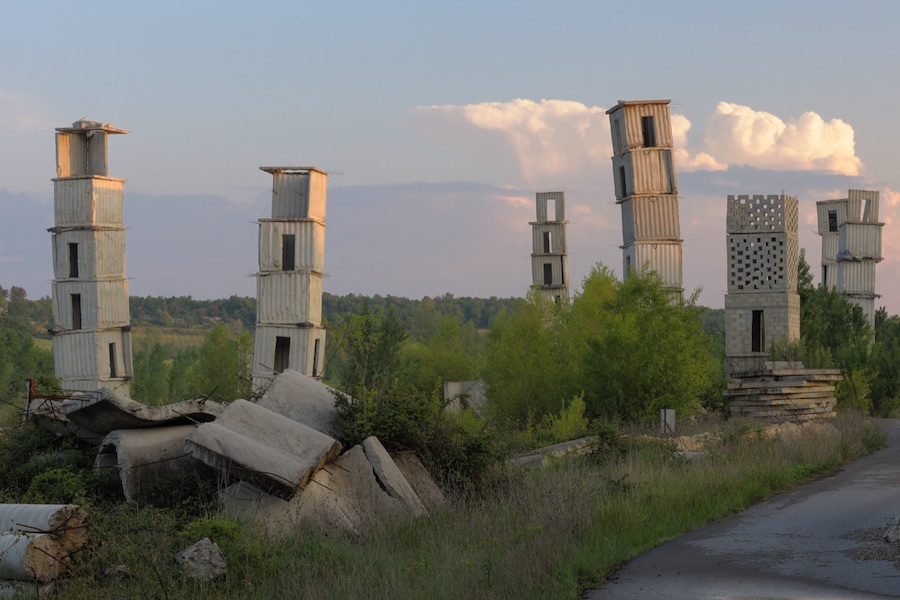
The Seven Heavenly Palaces. Photo: Charles Duprat. (c) Anselm Kiefer
This amazing artistic complex has hardly ever been visited, not yet being open to the public, and my tour of it was a succession of unique sensations, beginning at dusk as I made my way to the old silk factory where Anselm Kiefer and his trusty assistant Waltreaud were waiting for me. His face tanned, his eyes lively and intense, his smile inviting me to embark on our visit, we set off for the nearby buildings. We walked along paths lined with flora typical of the region and along which were placed sculptures of his characteristic lead books, symbolic of knowledge, strewn over or piled up on large blocks of stone, almost as if at any moment a sorcerer might emerge from the depths of the forest in some feat of alchemy.
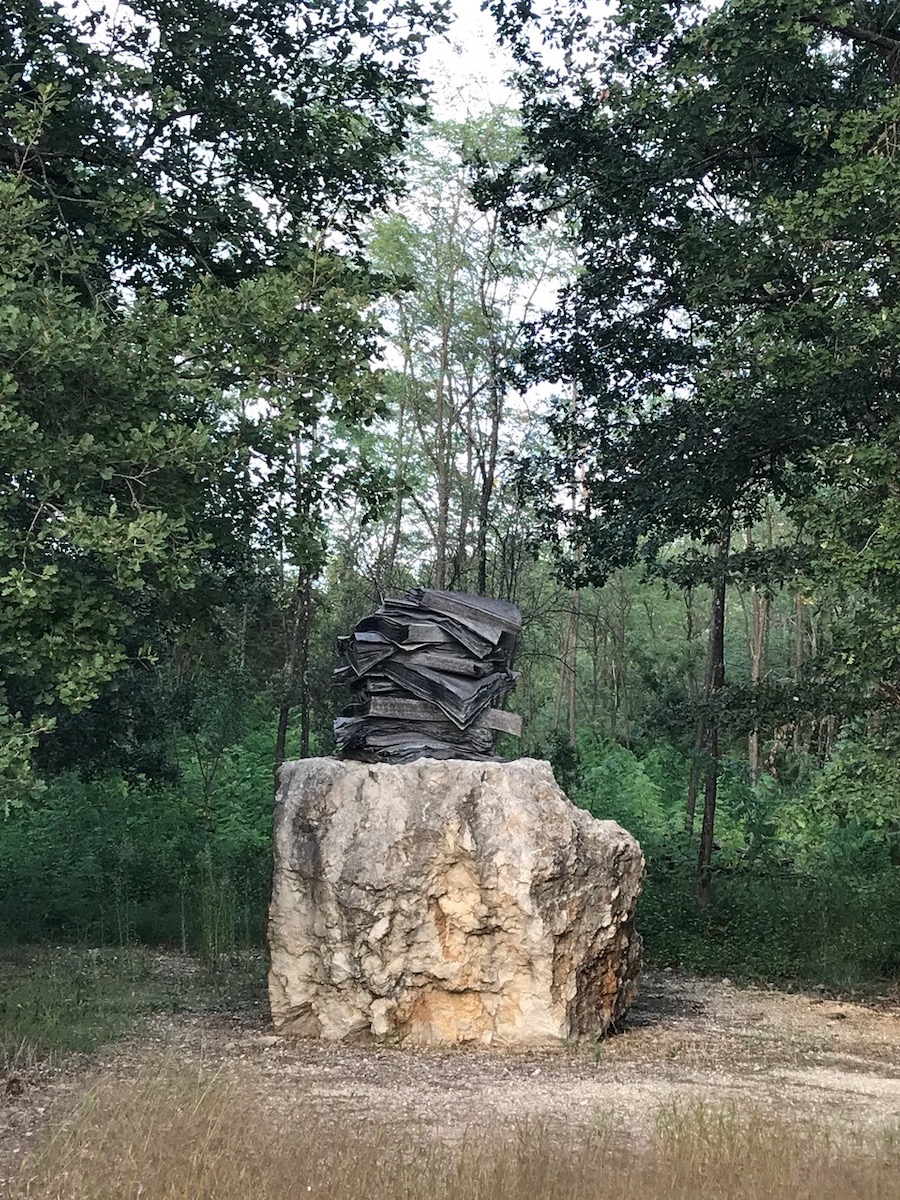
Anselm Kiefer. Barjac. Photo: Elena Cué
What first impacts me is a greenhouse topped with a World War II-like airplane made of lead with dried sunflowers spouting from it. Kiefer cultivates them here from Japanse seeds that grow to seven metres high. As if in a laboratory, he also cultivates tulips and other plants he will later use as materials for his work. These spaces devoted exclusively to one piece are the ones that resonate the most. We continue on to the next pavilions housing installations, paintings and sculptures all with the Holocaust as their theme. Kiefer's childhood was marked by a silence around what had happened: "When I was young, the Holocaust didn't exist. Nobody spoke about it in the 60's." He could feel there was something missing, something hidden and when he found out what it was, Kiefer tells me: "I was so affected by Hitler I started studying the Holocaust. I wanted to know what it was all about. What happened at that time is so horrible it's hard to imagine it." This would become a vital theme in his work.
In 1945, in the Black Forest, in the city of Donaueschingen where the two sources of the river Danube converge, Anselm Kiefer, one of the most prominant artists of our time, was born into a devastated Germany. While his mother was giving birth in the basement of a hospital, the family home was being blown to pieces by Allied bombs. The son of a Wehrmacht official, his childhood was marked by the authoritarianism of his father and a strict Catholic education.
Growing up in the ruins of a Germany that was destroyed and anxious to erase its tragic past awakened a profound interest in Kiefer to get to know about Judaism and the event that embodied archetypal evil - the genocide committed by Nazis. That catastrophe, so infinite, so boundless in its terror, so impossible to imagine let alone depict was to become the central strand in Kiefer's aesthetic and ethics.
Barely an hour later, I returned to the main house. In a huge, white, rectangular room of grandiose dimensions, the emptiness was only filled by one white linen sofa, some curtains hiding a bed at one end and an industrial kitchen with a large table of rustic wood at the other. I immediately joined the others for a supper that went on for five hours. Kiefer talked about the sensation he gets on seeing his paintings in retrospect, namely, a certain perception of his work as never being finished. As an aside, he mentioned how difficult it was to transport his "The Morgenthau Plan" from La Ribaute. This installation, housed in one of the pavilions, is the metaphorical conceptualization of the proposal masterminded shortly before the end of WWII by the US Secretary of the Treasury, Henry Morgenthau. The plan consisted of the elimination of Germany's industries and its subsequent transformation into an agricultural country. In it, Kiefer explores that would-be rural landscape: the resurgence of flowers from the devastation before. He considered it to be pure propaganda: "You know, all they did was help Hitler with this plan. They calculated that between 10 and 15 million Germans would die of hunger. And Roosevelt didn't want this. Hitler listened to Goebbels and, as far as they were concerned, it was a godsend; they would have the perfect excuse to maintain the German state by warning its citizens about what would happen if they didn't fight on. Not long ago, I also saw something about the Marshall Plan and that was all propaganda, too. Did you know that?"
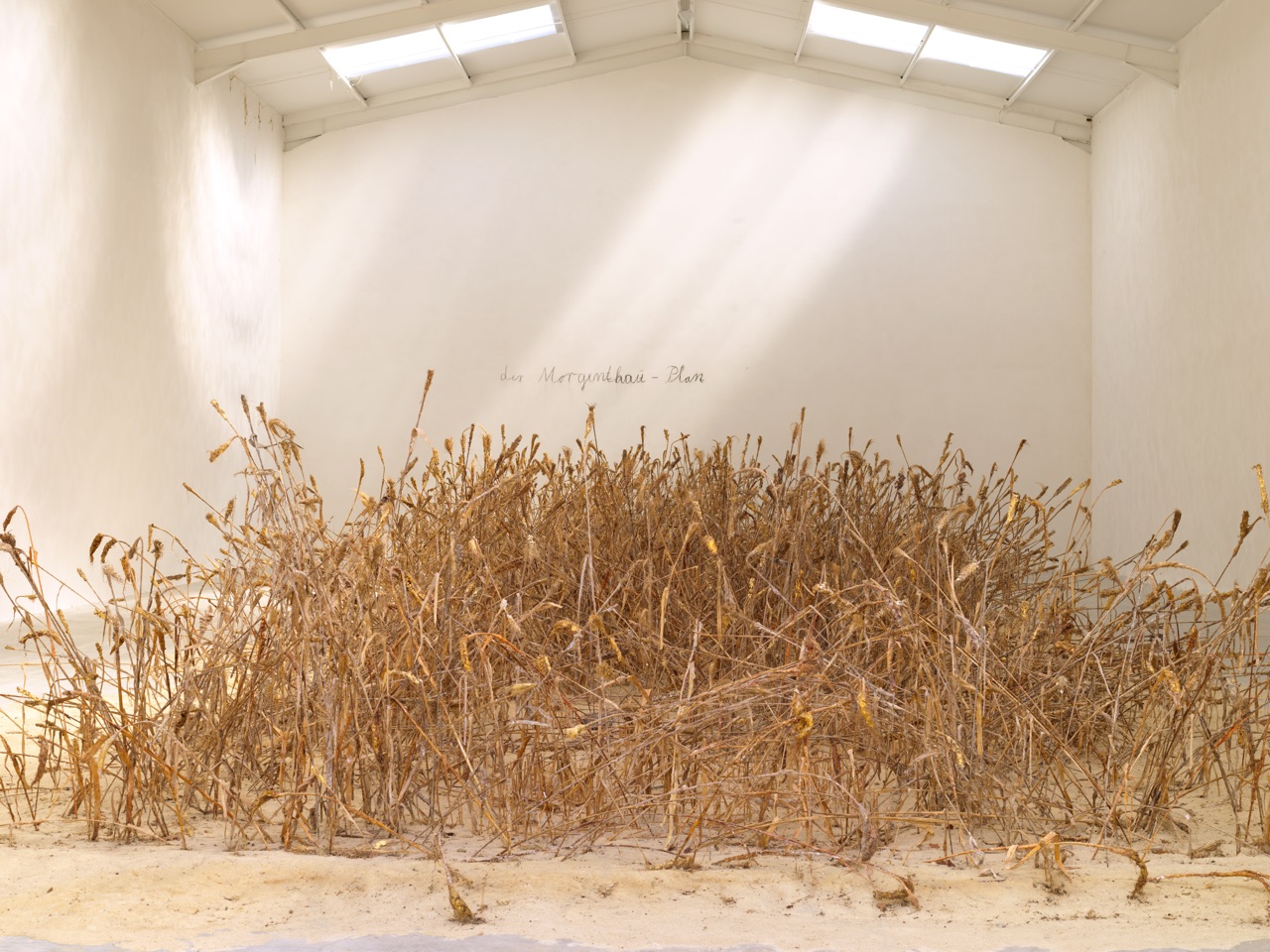
The Morgenthau Plan. Barjac. Anselm Kiefer. Photo: Charles Duprat. (c) Anselm Kiefer
The conversation went on so long that it got very late and I was invited to stay the night. The room, as with the rest of the building, was huge and somewhat intimidating as much for its dimensions as for the austerity of its minimalist decor. The following morning, we went to have a look at a series of the catacombs that are connected to each other like the creeping roots of a rhizome and to the pavilions above them at ground level. Before going underground, we went into the amphitheatre, which is the centrepiece of La Ribaute, as the artist was telling me: "The amphitheatre came about the same way a painting would. I had a large wall where I hung all my large paintings and I just thought, why not make a little grotto inside? So, I got hold of some containers and covered them with liquid cement and put them all together. The aim was just to have a little alcove in that big wall. Then, we continued with another layer on top, and another, etc and it kept on working out like a drawing. I've no idea how it will end up ...". This construction, 15 metres high, consists of different installations in each of the rooms within the containers. In one of them, there are reels of film, made out of strips of lead, hanging from the ceiling and featuring photographs taken by the artist thirty years ago.
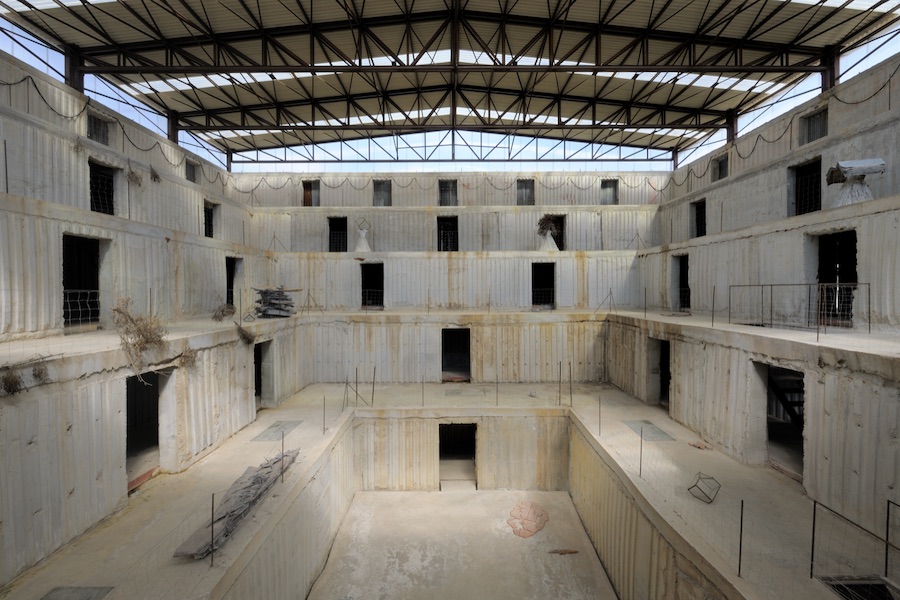
Amphitheatre. Barjac. Anselm Kiefer. Photo: Charles Duprat. (c) Anselm Kiefer
From there, we took an underground route that was somewhat reminiscent of a stone Gruyère cheese and I was immediately stopped in my tracks. Accessed by a narrow cave, we had come face to face with a deeply disturbing room, its walls lined with lead, the floor deep in water and a single light bulb hanging from a cable attached to the ceiling. Kiefer told me this was the first ever room he had completed and asked me, out of curiosity, what I thought of the acoustics. I answered that I hadn't experienced any sound at all. I'd been stunned into silence by what I saw.
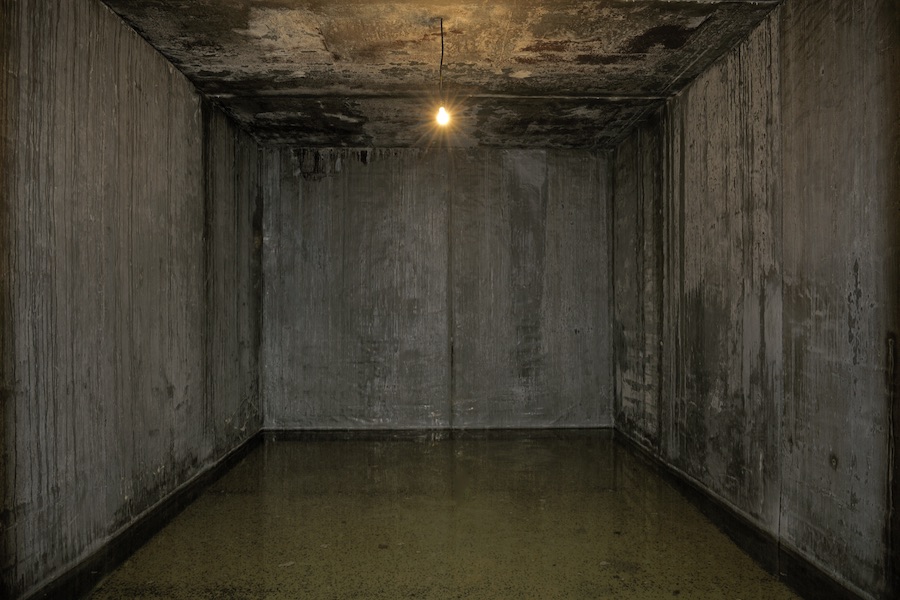
Lead Room. Anselm Kiefer. Photo: Charles Duprat. (c) Anselm Kiefer
As we make our way through the grottos, our perceptions change continually, the artist disappears and we are transported to other times, other places. Through these subterranean passages, we are able to travel to the Palaeolithic age, to the tragedies of Ancient Greece, to the time of Christ and to Auschwitz. And so we arrive at another impactful room: "The Women of the Revolution", sixteen beds with puddles of stagnant water on their rumpled, lead sheets giving the impression of skin or leather. This was the dividing line between the female interior and exterior that the artist uses as a metaphor for the immense inner power of women faced with the bravado of men. The highlight of the room is on the wall opposite - a lead panel picturing Kiefer with his back to us, in a landscape that very much reminded me of the German Romantic painter Caspar David Friedrich's "Wanderer Above A Sea Of Fog". It brought to mind the Kantian concept of the sublime and the inability of our imagination to grasp something so inestimable and so totally exceptional.
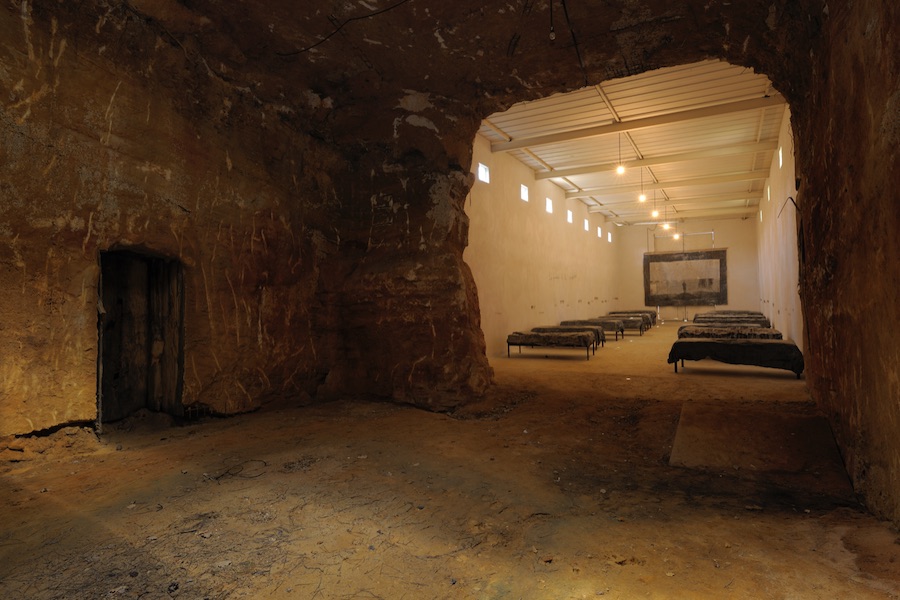
The Women Of The Revolution. Anselm Kiefer. Photo: Charles Duprat. (c) Anselm Kiefer
The tour over, I returned, even more staggered by the experience than before, to the main house to interview Kiefer. We talked at length over lunch during which time I discovered Kiefer's interest in science. He spoke with great admiration of the Spanish scientist Luis Alvarez-Gaume and his light particle teleportations to distances of tens of thousands of kilometres. "It's called teleportation. It happened to me and my grandmother. We used to think the exact same thoughts at the exact same time."
And we remembered Kant: "Every mention of the sublime has within it more enchantment than the phantasmagoric charms of the beautiful."
(Translated from the Spanish by Shauna Devlin)
- In the grotto of the Teuton. Anselm Kiefer in Barjac - - Alejandra de Argos -



